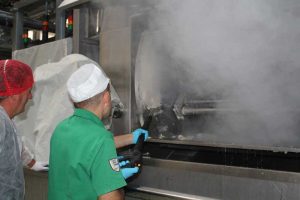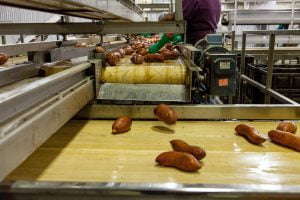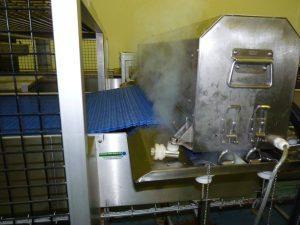In the UK, the Food Standards Agency (FSA) sets regulations and guidelines for food facilities to ensure the safety and quality of their products. These regulations include specific requirements for conveyor belt cleaning. According to the FSA’s Food Hygiene Rating Scheme, food businesses must have adequate procedures in place for cleaning and disinfecting equipment, including conveyor belts.
Non-compliance with these regulations can have serious consequences for food facilities. Failure to properly clean conveyor belts can result in a lower food hygiene rating, which can damage a facility’s reputation and lead to a loss of customers. In addition, non-compliance can also result in legal action, fines, or even closure of the facility. Therefore, it is crucial for food facilities to adhere to the regulatory requirements for conveyor belt cleaning to ensure compliance and maintain food safety.
Importance of Proper Conveyor Belt Cleaning in Food Facilities
Proper conveyor belt cleaning is essential for maintaining food safety in UK food facilities. Contaminated conveyor belts can pose several risks to consumers. Firstly, they can lead to the transfer of harmful bacteria onto food products, which can cause foodborne illnesses. Bacteria such as Salmonella and Listeria can cause symptoms such as nausea, vomiting, diarrhea, and in severe cases, can even be life-threatening.
In addition to bacterial contamination, conveyor belts can also become contaminated with allergens. This can pose a risk to individuals with allergies or intolerances who may have a severe reaction if they come into contact with even trace amounts of the allergen. Proper cleaning of conveyor belts is necessary to prevent cross-contamination and protect consumers with allergies.
Furthermore, contaminated conveyor belts can also lead to the presence of foreign objects in food products. These objects can range from small particles such as dirt or dust to larger objects such as metal fragments. Ingesting foreign objects can cause physical harm and pose a choking hazard to consumers. Therefore, regular cleaning of conveyor belts is crucial to remove any potential contaminants and ensure the safety and quality of food products.
Types of Conveyor Belt Cleaning Methods
There are several methods available for cleaning conveyor belts in food facilities. The choice of cleaning method depends on various factors such as the type of conveyor belt, the level of contamination, and the facility’s cleaning requirements.
One common method of conveyor belt cleaning is manual cleaning. This involves physically scrubbing the belt using brushes or sponges and a cleaning solution. Manual cleaning is effective for removing visible dirt and debris from the surface of the belt. However, it can be time-consuming and labor-intensive, especially for large facilities with long conveyor belts.
Chemical cleaning is another method used for conveyor belt cleaning. This involves using specific cleaning agents or disinfectants to remove bacteria and other contaminants from the surface of the belt. Chemical cleaning can be effective in killing bacteria and sanitizing the belt. However, it is important to use the appropriate cleaning agents and follow the manufacturer’s instructions to ensure the safety of food products and compliance with regulations.
Steam cleaning is a popular method for conveyor belt cleaning in food facilities. This involves using high-pressure steam to remove bacteria and other contaminants from the surface of the belt. Steam cleaning is effective in killing bacteria and sanitizing the belt without the use of chemicals. It is also a more efficient method compared to manual cleaning as it can cover larger areas in a shorter amount of time. However, steam cleaning may not be suitable for all types of conveyor belts, and it is important to consider the specific requirements of the facility before choosing this method.
Advantages of Using Steam Vapour Cleaning Machines
| Type of Cleaning Method | Description | Advantages | Disadvantages |
|---|---|---|---|
| Dry Cleaning | Using brushes, scrapers or air to remove dry debris from the belt surface. | Quick and easy to perform, minimal water usage, suitable for dry environments. | May not remove all types of debris, may cause dust to become airborne. |
| Wet Cleaning | Using water and cleaning agents to remove dirt and debris from the belt surface. | Effective at removing a wide range of debris, can be used in wet environments. | Requires more time and resources, may cause water damage to equipment if not done properly. |
| Steam Cleaning | Using high-pressure steam to remove dirt and debris from the belt surface. | Effective at removing stubborn debris, can sanitize the belt surface. | Requires specialized equipment, may cause water damage to equipment if not done properly. |
| Chemical Cleaning | Using chemicals to dissolve or break down dirt and debris on the belt surface. | Effective at removing stubborn debris, can sanitize the belt surface. | Requires specialized equipment and training, may cause damage to the belt if not done properly. |
Using steam vapour cleaning machines for conveyor belt cleaning offers several advantages over other methods. Firstly, steam cleaning is a chemical-free method, which means it does not leave any residue or chemical traces on the conveyor belt. This is particularly important in food facilities where any residue or chemical contamination can pose a risk to food safety.
Secondly, steam cleaning is highly effective in killing bacteria and sanitizing surfaces. The high temperature of the steam can penetrate into the pores of the conveyor belt, effectively killing bacteria and removing any contaminants. This ensures that the conveyor belt is thoroughly cleaned and reduces the risk of cross-contamination.
Furthermore, steam cleaning is a more efficient method compared to manual cleaning or chemical cleaning. Steam vapour cleaning machines can cover larger areas in a shorter amount of time, reducing labour costs and improving overall efficiency. This is particularly beneficial for large food facilities with long conveyor belts where manual cleaning may be time-consuming and impractical.
Features of Automatic Conveyor Belt Steam Vacuum
An automatic conveyor belt steam vacuum is a specialized piece of equipment designed specifically for conveyor belt cleaning. It combines the power of steam cleaning with the efficiency of a vacuum system to provide a thorough and effective cleaning solution.
One of the key features of an automatic conveyor belt steam vacuum is its ability to generate high-pressure steam. The steam is produced at a high temperature, which effectively kills bacteria and sanitizes the conveyor belt. The steam is then applied to the surface of the belt using a nozzle or brush attachment, ensuring that all areas are thoroughly cleaned.
In addition to steam cleaning, the automatic conveyor belt steam vacuum also incorporates a vacuum system. This system sucks up any dirt, debris, or moisture that is loosened by the steam cleaning process. This ensures that the conveyor belt is left clean and dry, reducing the risk of bacterial growth or contamination.
Another feature of the automatic conveyor belt steam vacuum is its ability to adjust the steam pressure and temperature. This allows for customization based on the specific requirements of the facility and the type of conveyor belt being cleaned. The equipment also includes safety features such as temperature control and pressure relief valves to ensure safe operation.
How to Choose the Right Conveyor Belt Cleaning Equipment

When choosing conveyor belt cleaning equipment, there are several factors to consider. Firstly, it is important to assess the size of the facility and the length of the conveyor belts. Larger facilities with longer belts may require more powerful equipment or multiple units to ensure efficient cleaning.
Secondly, it is essential to consider the type of conveyor belt being cleaned. Different types of belts may have different cleaning requirements or may not be suitable for certain cleaning methods. For example, belts with fabric surfaces may be more sensitive to heat and may require a gentler cleaning method.
Furthermore, it is important to consider the specific cleaning requirements of the facility. Some facilities may require more frequent cleaning or may have specific regulations or guidelines that need to be followed. It is important to choose equipment that can meet these requirements and ensure compliance with regulations.
Lastly, it is crucial to consider the budget and cost-effectiveness of the equipment. While it is important to invest in high-quality equipment that can effectively clean conveyor belts, it is also necessary to consider the long-term costs and maintenance requirements. It is advisable to choose equipment that is durable, easy to maintain, and has a good track record of performance.
Maintenance and Cleaning Procedures for Conveyor Belt Cleaning Equipment
Regular maintenance and cleaning of conveyor belt cleaning equipment are essential to ensure its optimal performance and longevity. Proper maintenance can also help prevent breakdowns or malfunctions that can disrupt operations and lead to downtime.
The specific maintenance and cleaning procedures may vary depending on the type of equipment and manufacturer’s recommendations. However, there are some general guidelines that can be followed.
Firstly, it is important to regularly inspect the equipment for any signs of wear or damage. This includes checking for loose or damaged parts, leaks, or any other issues that may affect the performance of the equipment. Any issues should be addressed promptly to prevent further damage or breakdowns.
Secondly, it is necessary to clean the equipment regularly to remove any dirt, debris, or residue that may accumulate during use. This can be done using a mild detergent or cleaning solution and a soft cloth or sponge. It is important to follow the manufacturer’s instructions for cleaning and avoid using abrasive materials or harsh chemicals that may damage the equipment.
Furthermore, it is important to regularly check and replace any filters or other consumable parts as recommended by the manufacturer. This ensures that the equipment continues to operate at its optimal performance and prevents any contamination or reduced efficiency.
Lastly, it is advisable to keep a record of all maintenance and cleaning activities performed on the equipment. This can help track any issues or trends over time and ensure that regular maintenance is being carried out as required.
Training Requirements for Conveyor Belt Cleaning Personnel
Proper training is essential for personnel responsible for conveyor belt cleaning to ensure compliance with regulations and effective cleaning practices. Training should cover various aspects, including the importance of conveyor belt cleaning, the specific cleaning procedures, and the safe operation of cleaning equipment.
Personnel should be trained on the potential risks associated with contaminated conveyor belts and the importance of preventing cross-contamination. They should understand the consequences of non-compliance with regulations and the impact it can have on food safety and the facility’s reputation.
Training should also cover the specific cleaning procedures for conveyor belts, including the use of cleaning agents, equipment operation, and safety precautions. Personnel should be familiar with the different cleaning methods available and understand when to use each method based on the specific requirements of the facility.
Furthermore, personnel should receive training on the safe operation of cleaning equipment, including steam vapour cleaning machines or automatic conveyor belt steam vacuums. They should understand how to adjust steam pressure and temperature, how to properly use attachments or nozzles, and how to safely handle and store cleaning agents.
Regular refresher training should also be provided to ensure that personnel stay up-to-date with any changes in regulations or cleaning procedures. This can help reinforce good practices and ensure that personnel continue to follow proper cleaning protocols.
Ensuring Compliance with Conveyor Belt Cleaning Regulations in the UK
In conclusion, conveyor belt cleaning is a critical aspect of maintaining food safety in UK food facilities. Contaminated conveyor belts can pose serious risks to consumers, including bacterial contamination, allergen cross-contamination, and foreign object contamination. Therefore, it is essential for food facilities to implement proper cleaning procedures to prevent these risks.
Compliance with regulatory requirements for conveyor belt cleaning is crucial to ensure food safety and maintain the reputation of food facilities. The Food Standards Agency (FSA) sets regulations and guidelines for food businesses in the UK, including specific requirements for conveyor belt cleaning. Non-compliance can result in lower food hygiene ratings, legal action, fines, or closure of the facility.
There are various methods available for conveyor belt cleaning, including manual cleaning, chemical cleaning, and steam cleaning. Steam cleaning, particularly using steam vapour cleaning machines or automatic conveyor belt steam vacuums, offers several advantages over other methods. It is chemical-free, highly effective in killing bacteria, and more efficient compared to manual or chemical cleaning.
When choosing conveyor belt cleaning equipment, it is important to consider factors such as the size of the facility, the type of conveyor belt, and the specific cleaning requirements. Regular maintenance and cleaning of the equipment are also essential to ensure optimal performance and longevity.
Proper training is necessary for personnel responsible for conveyor belt cleaning to ensure compliance with regulations and effective cleaning practices. Training should cover the importance of conveyor belt cleaning, specific cleaning procedures, and safe equipment operation.
Overall, compliance with conveyor belt cleaning regulations and proper cleaning practices are essential to protect consumers and maintain food safety in UK food facilities. By implementing effective cleaning procedures and using appropriate equipment, food facilities can ensure the safety and quality of their products.
FAQs
What are conveyor belts in food facilities?
Conveyor belts are mechanical devices used to transport food products and ingredients from one area of a food facility to another.
Why is regular cleaning of conveyor belts important in food facilities?
Regular cleaning of conveyor belts is important in food facilities to prevent the buildup of harmful bacteria, allergens, and other contaminants that can cause foodborne illnesses.
What regulations require regular cleaning of conveyor belts in food facilities?
In the UK, food facilities are required to comply with the Food Safety Act 1990, which mandates that all food businesses must ensure that food is safe for consumption. The Food Standards Agency (FSA) also provides guidance on food hygiene and safety, including the regular cleaning of conveyor belts.
What are the consequences of not regularly cleaning conveyor belts in food facilities?
Failure to regularly clean conveyor belts in food facilities can result in the contamination of food products, which can lead to foodborne illnesses and outbreaks. This can have serious consequences for both the health of consumers and the reputation of the food facility.
What are some best practices for cleaning conveyor belts in food facilities?
Best practices for cleaning conveyor belts in food facilities include using food-grade cleaning solutions, following manufacturer instructions for cleaning and maintenance, and implementing a regular cleaning schedule. It is also important to train staff on proper cleaning procedures and to regularly monitor and document cleaning activities.










